TerraMaster D8 Hybrid drive enclosure review: Lots of data, not enough bandwidth
If you need a lot of storage in about as small an enclosure as you can get, the TerraMaster D8 Hybrid fuses hard drive and SSD storage -- but with a crucial speed limitation.
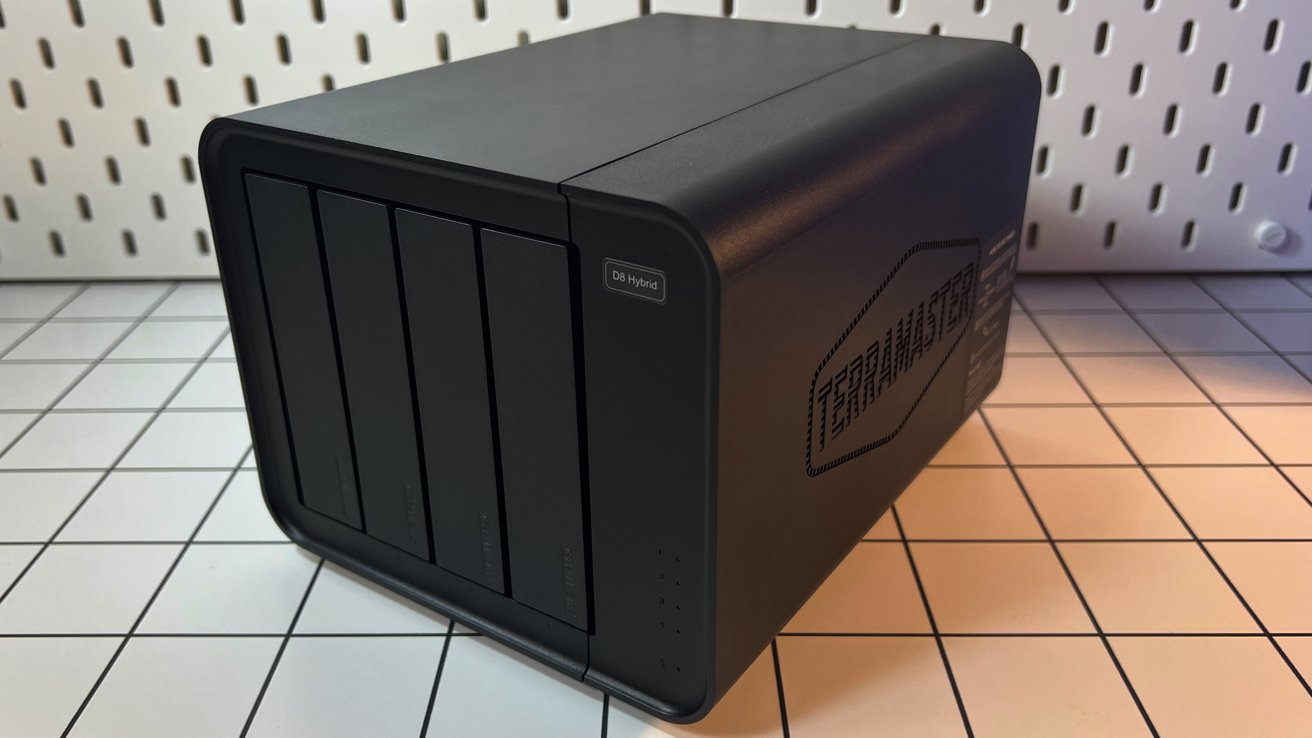
TerraMaster D8 Hybrid review
It's been a quiet evolution, but external drive enclosures have changed significantly in the last ten years. A decade ago, expensive and high-speed Thunderbolt or lower-cost USB 3 enclosures were the name of the game. USB-C has changed that a bit.
But that class divide is still there. Thunderbolt and USB-4 are now 40 gigabits per second and pricey.
The alternative is still USB-C, but with USB 3 in various incarnations. Those are 5 gigabit scaling to a practical maximum of 10 gigabit on the Mac.
The TerraMaster D8 Hybrid has a lot of bays, with four of them for super-high-speed storage. That's a lot of storage in a small space, yes, but there's no real way to take good advantage of the high-speed storage slots.
But, it still has a pretty good cost-to-feature ratio -- assuming you buy it very soon, or on sale.
TerraMaster D8 Hybrid review - Features and design
The TerraMaster D8 Hybrid is an 8-bay Hybrid RAID enclosure. It's designed to expand your Mac's available storage by holding several drives. The downside is that they all connect via USB 3.2.
The device earns its Hybrid name due to the type of drives it can hold. The four trays can hold four 24TB SATA hard drives, referred to as cold storage, and the main storage for the unit.
It can also hold four NVMe M.2 SSDs, which the company calls hot storage. The idea is that users can choose to store data on slower cold storage or faster hot storage, depending on their needs.
This is an artificial distinction, really. Users have been distinguishing what needs to be on fast storage and what needs to be on slower storage for a very long time. There's no compelling need to break it down now.
And besides, it's not like the two different media types will deliver that much quicker or slower. The USB connection is the main limitation.
That means there's a total storage capacity of 128TB, with 96TB of hard drive space and 32TB of SSD space. The retail price on this would be close to $3200 for the SSDs and $1800 for the hard drives. If you're going to spend $5000 on hard drives, you're also probably also looking for more performant enclosures.
At 8.74 inches by 7 inches by 6 inches, the unit is fairly compact for what it contains. The power supply is external, which is fine.
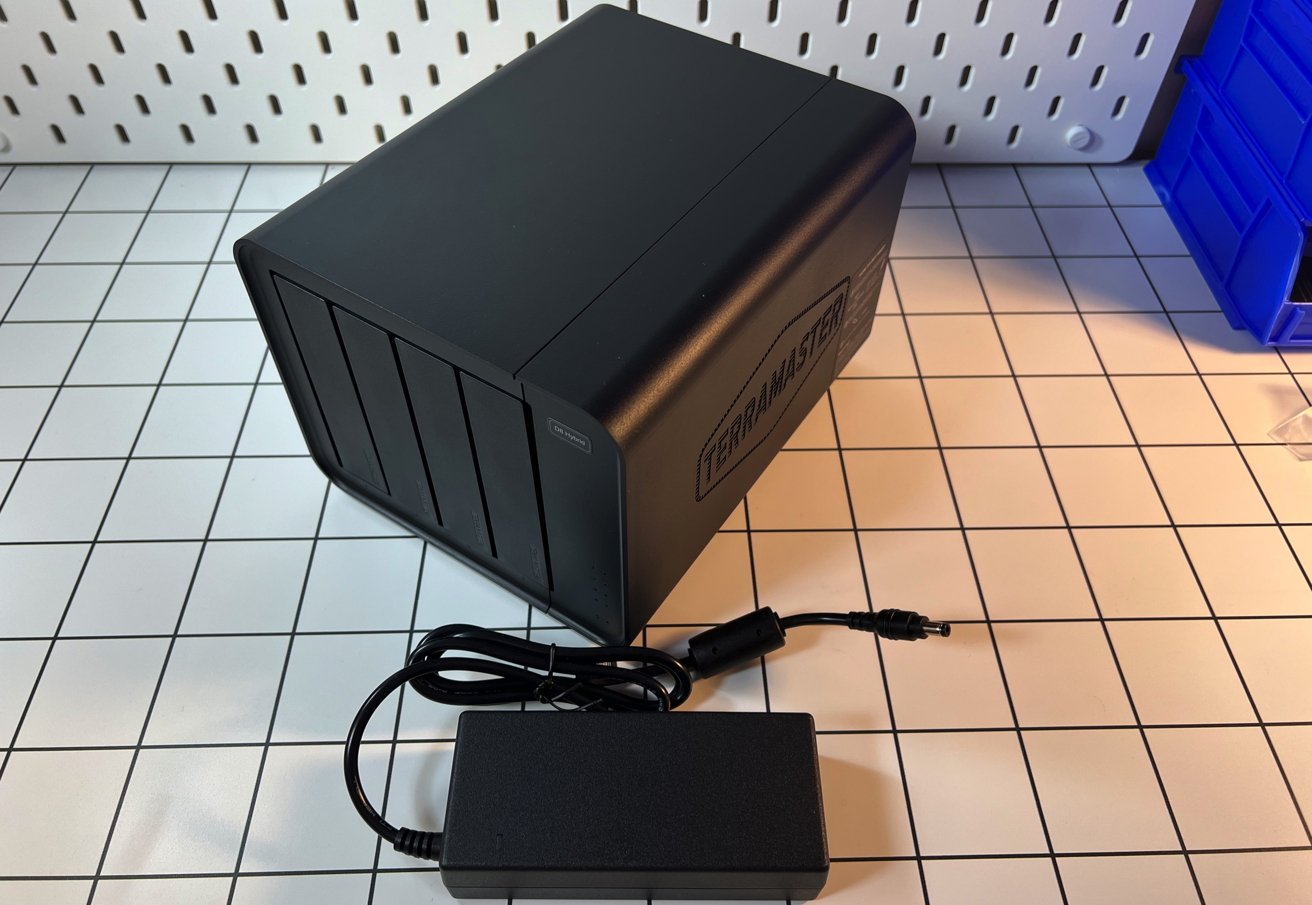
TerraMaster D8 Hybrid review: Enclosure and power adapter
Its 4.1-pound unladen weight is beefy, but not out of bounds for a metal- and plastic-clad drive enclosure. It's about double that when packed with drives, with most of the weight in spinning metal and attendant casings.
The fan on the back automatically adjusts speeds based on hard drive temperatures and runs as quietly as 21 decibels. In practice and under load, our testing saw this hit 40 decibels at one meter from the unit. Some of this is drive chatter, but most is the fan.
TerraMaster D8 Hybrid review - Drive mounting and RAID configuration
On the front are four drive slots intended for the hard drives. Each uses a tool-free tray with a push-lock auto-locking system to prevent accidental unmounting.
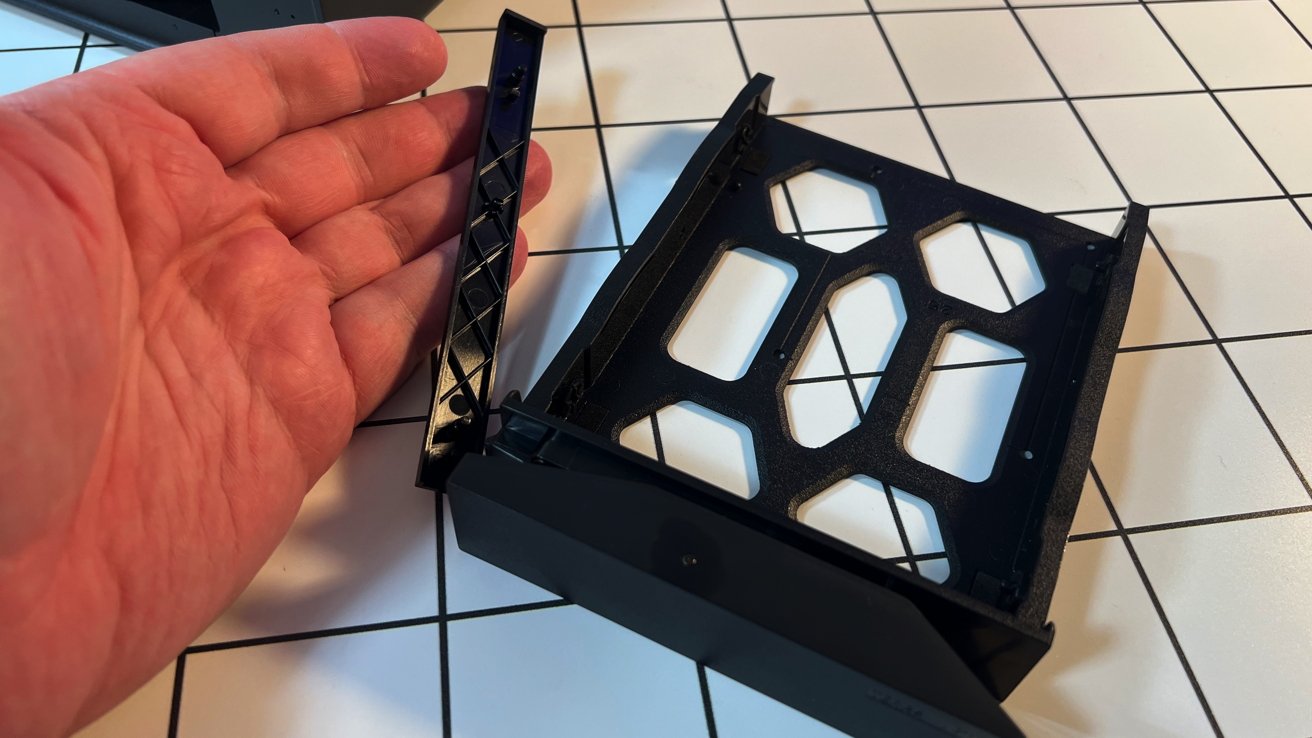
TerraMaster D8 Hybrid review: Hard drive sleds
The trays are pretty good. I've seen the pull-strip in enclosures before, and overall, I like them.
They're not designed for routine drive insertion and removal if you're inclined to swap out storage often. This isn't a major crisis, considering that most drive enclosures get storage put in and are only rarely removed for failure or upgrade.
A cover and a few screws contain the M.2 drives on one side of the unit. If you've ever built a PC, you've got a pretty good handle on how the drives install.
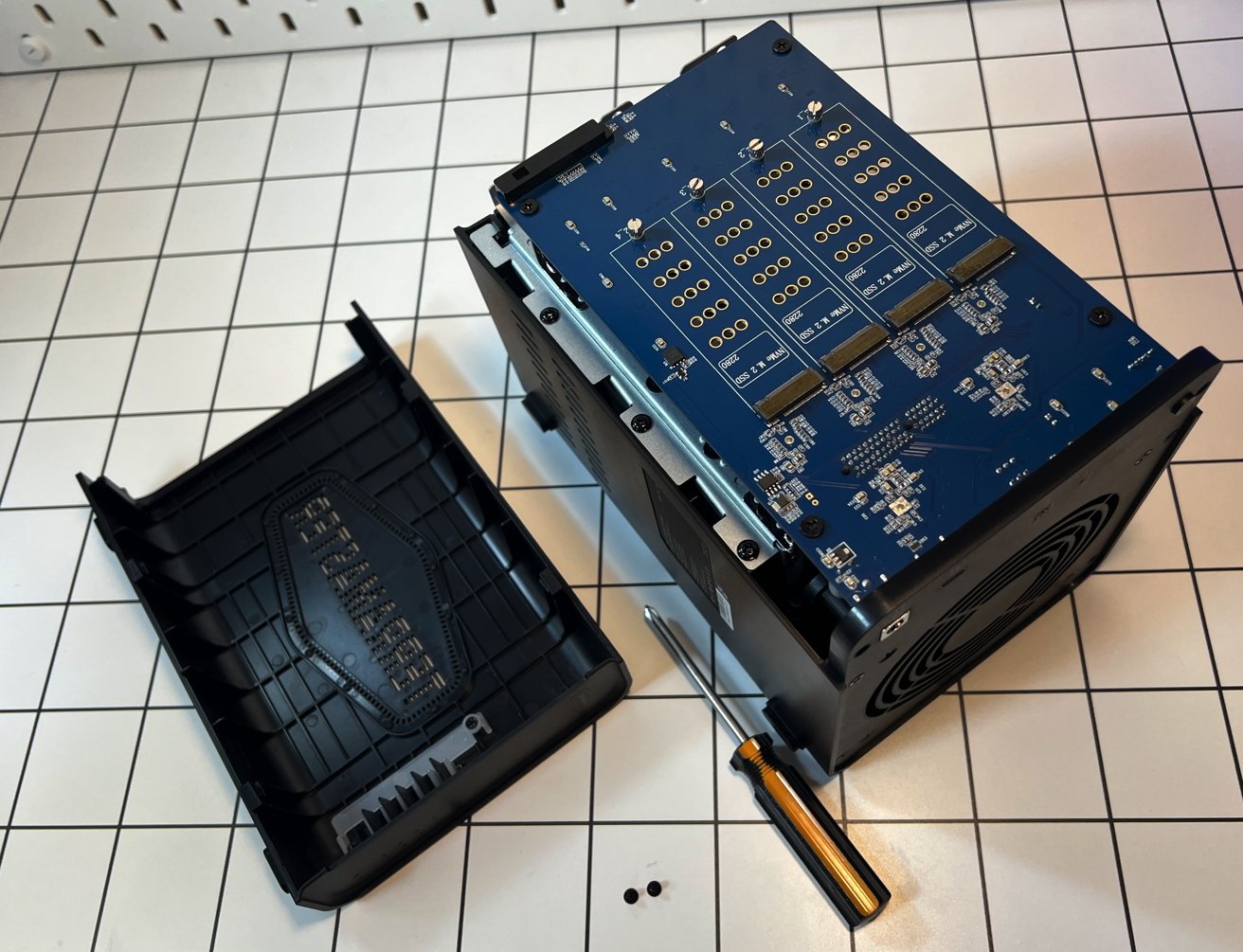
TerraMaster D8 Hybrid review: M.2 slots
If you haven't, it's pretty straightforward. Insert the M.2 drive into the slot, press the tail of the drive down, and screw it down.
There's no real room for bulky heat sinks on the M.2 drives here. There's also no need to buy storage for it that needs those sinks, given the speed of the enclosure.
Around the back is an old-school drive mode selector that we don't particularly like. This allows users to switch between four different ways of handling the data.
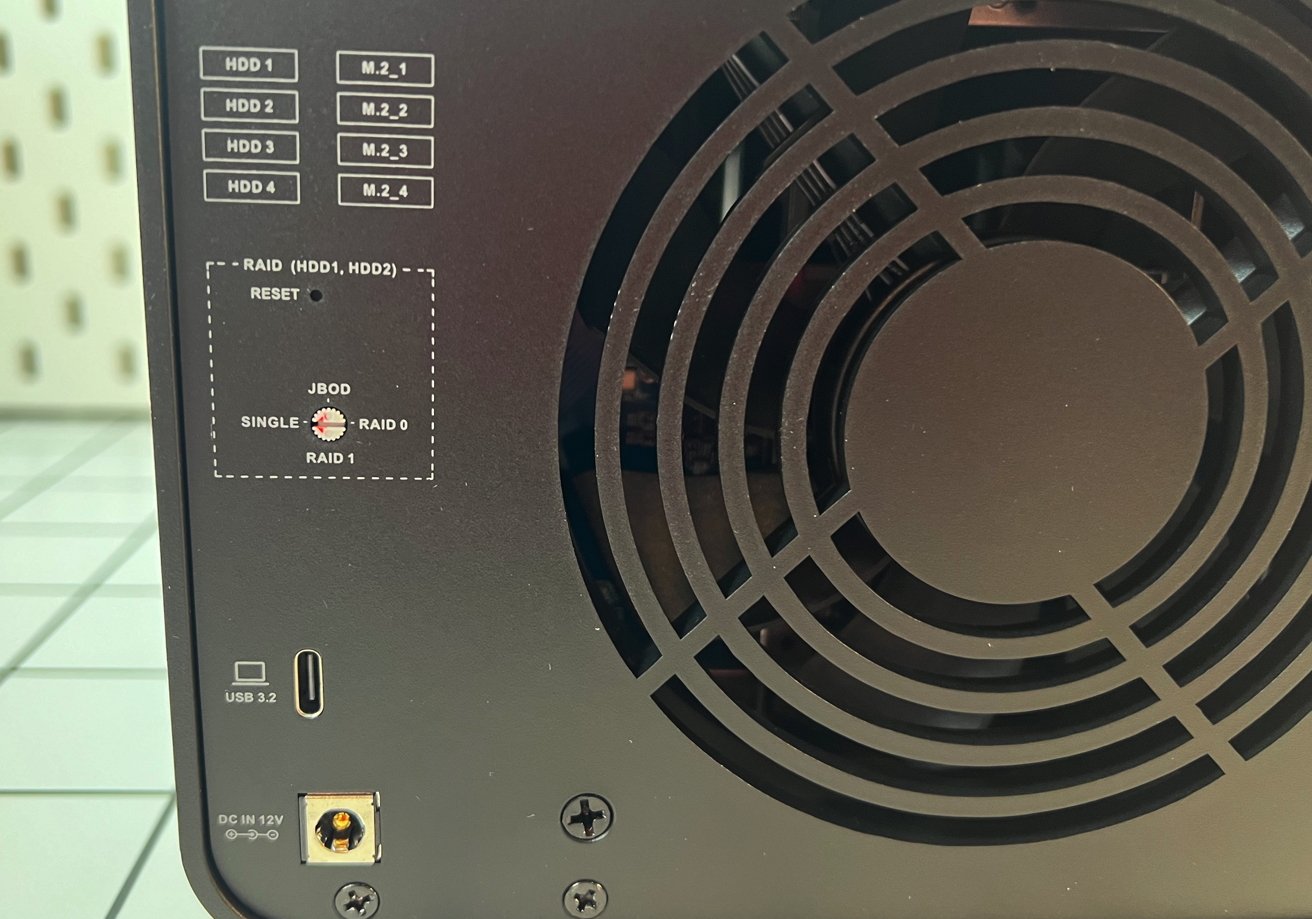
TerraMaster D8 Hybrid review: RAID selector and back panelTerraMaster D8 Hybrid review: RAID selector and back panel
It can support JBOD Mode, turning the drives into a single storage space. We don't recommend this, really. There's no speed benefit, and one drive failing will take down the entire array.
Single Mode lets each drive be stored independently. This is what we recommend for the most part. Put that switch in Single Mode, forget about it, and let macOS Disk Utility handle the RAID 0 or 1 configuration.
Raid 0 and Raid 1 modes are selectable by that switch for two of the four hard drive bays. Again, we don't recommend this.
It is also possible to set up a 2+6 Raid mode, which sets aside two hard drives for Raid 0 and 1 use. The other two hard drives and the four NVMe drives act as a single disk.
As you'd expect for direct storage, there are a series of indicator lights on the front. They happily blink away in blue and are easy to mask off with electrical tape. There's no way to turn them off.
TerraMaster D8 Hybrid review - Enclosure performance
While it looks like a network-attached storage device, and some of the ad copy alludes to that in part, it's actually designed to be connected directly to a computer. It connects using a USB-C port on the back, operating at USB 3.2 Gen 2 speeds, 10Gbps.
In use, TerraMaster claims the D8 Hybrid offers read speeds of 560MB/s for a single SATA SSD, or 1,016MB/s when accessing all four bays with SSDs. The write speeds are 520MB/s for one drive max, limited to 960MB/s for four because of USB 3.2 Gen 2 limits.
The M.2 drives are said to read at up to 980MB/s per individual drive, with 880MB/s for the write speed.
Our testing bears the company's claims. This is unsurprising, given that four high-speed hard drives alone can saturate the USB-C connection.
We like that no additional software installation is required like there is for some Thunderbolt RAID enclosures. We don't like that the USB-C type 3.2 connection is holding the unit back.
TerraMaster D8 Hybrid review - Buy it at the right price
I've tested an absolute pile of drive enclosures. They all have varying price points and performances. It's hard to find a good balance.
While I like the engineering and design of the TerraMaster D8 Hybrid, it isn't what you'd call a high-end enclosure. It can pack a lot of storage into a small space, which is nice.
With any peripheral, you are limited to the slowest performing component, be it the drives or the cable. In this case, there are more than enough drives for massive speed, but that USB-C type 3.2 connector can be a problem - depending on how much you pay for it.
At press time, the Kickstarter for this enclosure is ongoing. The launch special is about $200 for the enclosure, with a promised retail price of $299.
I'd be comfortable paying $199 for this, but I wouldn't be excited at $299. If you want data density, there are four, and even five-bay enclosures for hard drives at $200 or less on Amazon. This will do for most casual data storage needs.
And, if you want, you can go crazy. An enclosure that holds 10 SATA 3.5-inch drives in one 10-gigabit enclosure goes for about $600 at full retail price.
Terabyte to terabyte, SSD storage in either SATA form or M.2 is far more expensive than hard drives. You get a lot better speed from the SSDs, obviously. It feels like putting four M.2 drives in this unit isn't worth the cost plus $100 for the enclosure at retail over a hard drive enclosure from another vendor for the performance you get.
This all said, TerraMaster did a pretty good job engineering this enclosure. It doesn't get hot, is not particularly loud, and is sufficiently performant for light use and data warehousing.
And, I get it. Thunderbolt and USB 4 40 gigabit connections are expensive to engineer.
All told in a best case scenario, enough drives to fully populate the TerraMaster D8 Hybrid unencumbered by cabling slowing things down could deliver about 12 gigabytes per second for the aforementioned cost of about $5000. But, instead, they are channeled through a one gigabyte per second funnel. What we've got is like trying to drain a swimming pool with a garden hose.
With the TerraMaster D8 Hybrid, you'll get there inexpensively. But, you're going to need to be patient.
Sometimes, the garden hose is enough since the price can be right.
TerraMaster D8 Hybrid review - Pros
- Relatively quiet
- Runs cool
- Lots of storage in a small space, but...
TerraMaster D8 Hybrid review - Cons
- All that storage is super-throttled by USB 3.2 bandwidth
- Full retail cost to performance isn't great
In our ongoing battle with effectively Google-mandated star ratings, once again, the TerraMaster D8 Hybrid is hard to score. At full retail price, the cost-to-what-you-get ratio isn't great. At $199, it's far better.
As a matter of procedure, our main score is based on retail cost. At $299, the TerraMaster D8 Hybrid is a 3 out of 5. If you get it for $199 during the Kickstarter or on sale afterward on Amazon or the like, it's a strong 4 out of 5 for data density alone.
We're not sure what sale prices will be after the Kickstarter, though. So, maybe, if this suits your needs, now is the best time to buy.
Score: 3 out of 5
Where to buy the TerraMaster D8 Hybrid
As of May 30, the TerraMaster D8 Hybrid Kickstarter is ongoing and long since funded. Purchasers can still buy the unit for $199 plus shipping. The company promises a retail price of $299, which is likely what it will sell for routinely on Amazon.
Delivery of any crowdfunded project is not guaranteed. We do not cover Kickstarters for which we do not have the hardware.
However, TerraMaster is an established company with a long history. We're almost certain that the product will ship.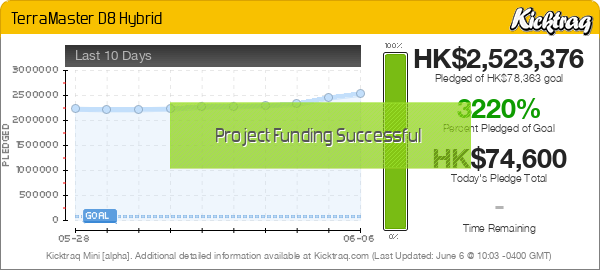
Read on AppleInsider

Comments
I really just need raw storage and because mini PC are so cheap it's pretty easy to dedicate one to managing the storage and applications as a duopoly.
The problem with affordable NAS is you get below average hardware to run the NAS.
I can envision that having an SSD on the receiving side may provide some performance benefit for large data transfers depending on how multi-packet data is reassembled and stored on the receiving side. But again, this is probably something that would be done as part of a cache or buffer before committing to persistent storage. The hot storage option takes things up to the application level with dependencies on application data access patterns, which may benefit ever so slightly by having dedicated SSD storage. But still, without a fast pipe like Thunderbolt or USB4 the whole hot storage thing seems rather limited in use. Only one way to find out - measure / benchmark the performance.
The enclosure appears as individual drives, or not, as configured by that rotator switch.
It would be nice to see what possible setups, new or old, could be created.
The footprint bothers me. Drobo stacked the drives leaving a small footprint. TerraMaster, Synology and others put the drives side-by-side, taking up more space than I'd like. Changing the native orientation to stacked drives would allow two TerryMaster enclosures in about the same space as the current D8 H.